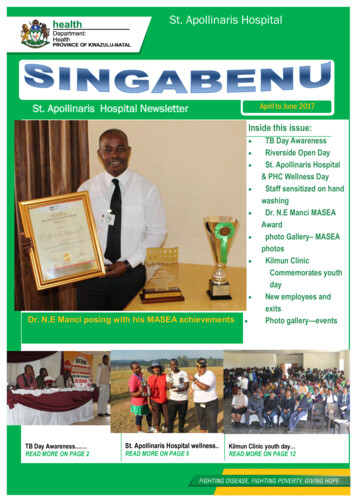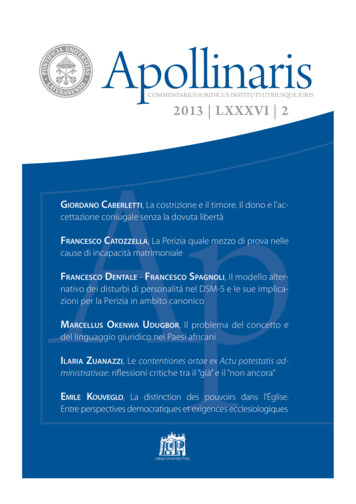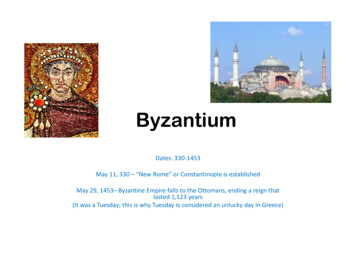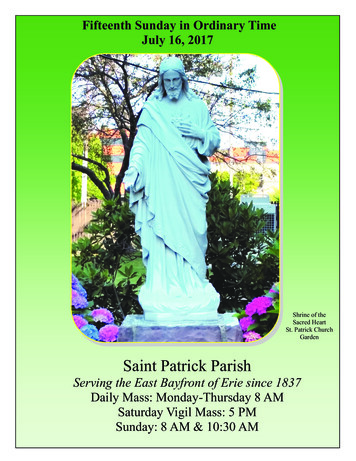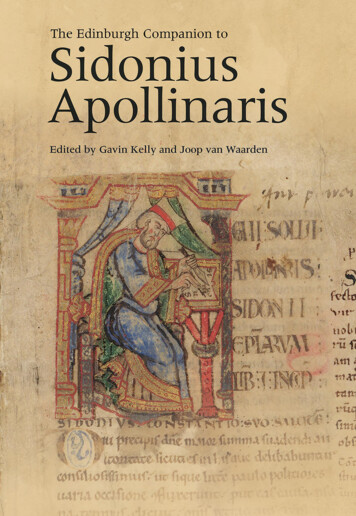
Transcription
THE EDINBURGH COMPANIONSIDONIUS APOLLINARIS6255 Kelly and van Waarden Part 1.indd iTO13/02/20 4:00 PM
6255 Kelly and van Waarden Part 1.indd ii13/02/20 4:00 PM
THE EDINBURGHCOMPANION TO SIDONIUSAPOLLINARISEDITED BY GAVIN KELLY ANDJOOP VAN WAARDEN6255 Kelly and van Waarden Part 1.indd iii13/02/20 4:00 PM
Edinburgh University Press is one of the leading university presses in the UK.We publish academic books and journals in our selected subject areas across thehumanities and social sciences, combining cutting-edge scholarship with higheditorial and production values to produce academic works of lasting importance.For more information visit our website: edinburghuniversitypress.com editorial matter and organisation Gavin Kelly and Joop van Waarden, 2020 the chapters their several authors, 2020Edinburgh University Press LtdThe Tun – Holyrood Road, 12(2f ) Jackson’s Entry, Edinburgh EH8 8PJTypeset in 10 / 12 Bembo byIDSUK (DataConnection) Ltd, andprinted and bound in Great Britain.A CIP record for this book is available from the British LibraryISBN 978 1 4744 6169 6 (hardback)ISBN 978 1 4744 6170 2 (webready PDF)ISBN 978 1 4744 6171 9 (epub)The right of Gavin Kelly and Joop van Waarden to be identified as the Editor ofthis work has been asserted in accordance with the Copyright, Designs and PatentsAct 1988, and the Copyright and Related Rights Regulations 2003 (SI No. 2498).This book was made possible by an International Network grant from theLeverhulme Trust and a British Academy/Leverhulme Small Research Grant.6255 Kelly and van Waarden Part 1.indd iv13/02/20 4:00 PM
CONTENTSAcknowledgementsAuthor BiographiesNoteAbbreviations for Books, Series, and Reference WorksMap of Sidonius’ Gaul c. 380–c. 480IntroductionGavin Kelly and Joop van Waardenviiixxiiixvxviii1Part I Sidonius’ Life, the Characters in his Work, and its Dating1. Sidonius’ Biography in Photo NegativeJoop van Waarden132. Sidonius’ PeopleA Prosopography of SidoniusSidonius’ Places: A Geographical AppendixRalph W. Mathisen29761553. Dating the Works of SidoniusGavin Kelly166Part II Sidonius in his Political, Social, and Religious Context4. Sidonius’ Political WorldMichael Kulikowski1975. Sidonius’ Social WorldSigrid Mratschek2146. Creating Culture and Presenting the Self in SidoniusSigrid Mratschek2377. Sidonius and ReligionLisa Kaaren Bailey2616255 Kelly and van Waarden Part 1.indd v13/02/20 4:00 PM
viCONTENTSPart III Sidonius’ Work in its Literary Context8. Sidonius’ IntertextualityIsabella Gualandri2799. Sidonius’ PanegyricsAnnick Stoehr-Monjou31710. Sidonius’ Shorter PoemsFranca Ela Consolino34111. Sidonius’ CorrespondenceRoy Gibson373Part IV Sidonius’ Language and Style12. Sidonius’ Vocabulary, Syntax, and StyleÉtienne Wolff39513. ‘You’ and ‘I’ in Sidonius’ CorrespondenceJoop van Waarden41814. Metrics in SidoniusSilvia Condorelli44015. Prose Rhythm in SidoniusJoop van Waarden and Gavin Kelly462Part V The Manuscript Tradition and the History of Scholarship16. The Manuscript Tradition of SidoniusA Census of the Manuscripts of SidoniusFranz Dolveck47950817. Sidonius Scholarship: Fifteenth to Nineteenth CenturiesLuciana Furbetta54318. Sidonius Scholarship: Twentieth to Twenty-First CenturiesSilvia Condorelli56419. Translating SidoniusRoger Green618Part VI Readers of Sidonius from Antiquity to the Present20. Sidonius’ Earliest Reception and DistributionRalph W. Mathisen63121. Glossing Sidonius in the Middle AgesTina Chronopoulos64322. Sidonius in the Middle Ages and the RenaissanceJesús Hernández Lobato6656255 Kelly and van Waarden Part 1.indd vi13/02/20 4:00 PM
CONTENTSvii23. Sidonius Reception: Sixteenth to Nineteenth CenturiesJoop van Waarden68624. Sidonius Reception: Late Nineteenth to Twenty-First CenturiesFilomena Giannotti705Epilogue: Future Approaches to SidoniusGavin Kelly and Joop van Waarden730BibliographyIndex LocorumGeographical IndexIndex of Personal Names (Antiquity)Index of Personal Names (After Antiquity)Index of Topics7377978198238358376255 Kelly and van Waarden Part 1.indd vii13/02/20 4:00 PM
ACKNOWLEDGEMENTSThis book has its roots back in the first decade of the century. During the writing of hisdoctorate, a commentary on the block of eleven letters to bishops that stand at the startof Book 7 of Sidonius’ letters, Joop van Waarden had built up links with a wide rangeof scholars, and founded a website that increasingly came to serve as an informal message board. It was his conviction that a comprehensive approach, one which treated bothprose and poetry, crossed the disciplinary divide between literature and history, and addedfurther disciplines, would bring benefits. He was able to organise an international workshop at Wassenaar in 2011 to consider such an approach thanks to the support of HagitAmirav, Bas ter Haar Romeny, and Paul van Geest (and the Dutch Centre for PatristicResearch generally), who successfully applied for a grant from the Netherlands Institute forAdvanced Study in the Humanities and Social Sciences (NIAS).The interdisciplinary approach appealed to Gavin Kelly, and van Waarden and he joinedforces. Thus, the Wassenaar workshop, which led to van Waarden and Kelly, New Approachesto Sidonius Apollinaris (2013), was also the point at which the idea for the present Companioncrystallised, as one of two strands of systematic work in the project ‘Sidonius Apollinaris forthe 21st Century’ – the other being a series of commentaries.A work like this is inherently complex, long in gestation, and dependent on many peopleand institutions. Having reached the moment of publication, we are extremely grateful toeverybody who made this possible in the first place, and for the trust, the competence, thezest, and the patience with which they made the result surpass all our expectations.We would first of all like to thank the Leverhulme Trust for funding the InternationalNetwork ‘Sidonius Apollinaris for the 21st Century’ during the years 2014–17, covering aNetwork Facilitator, conference costs, translation and editing costs of the Companion and threecommentary volumes, and travel costs for research, especially on the manuscript tradition ofSidonius. We are also grateful to the British Academy for a Small Research Grant, and to theClassical Association for a conference grant, for the project’s inaugural conference, ‘Sidonius,his Words and his World’, in Edinburgh from 20 to 23 November 2014. We are also obligedto Edinburgh University’s School of History, Classics, and Archaeology for a contributiontowards organising this conference, and to many other universities for enabling various speakers and participants to assist. A special word of thanks is due to the student helpers Alison John,Giulia Sagliardi, and Belinda Washington.6255 Kelly and van Waarden Part 1.indd viii13/02/20 4:00 PM
ACKNOWLEDGEMENTSixWe are grateful to Jill Harries and to the Project Advisory Board, Hagit Amirav, Jan Willem Drijvers, Roy Gibson, and Roger Rees, for their expert advice. Our meticulous NetworkFacilitator, Paul Barnaby, translated a number of chapters and also contributed numerousimprovements. We also warmly thank the other translators: Maria Giulia Franzoni, AlexandreJohnston, and Giulia Sagliardi. Many thanks go to Pieter van Waarden for designing the mapof Gaul.We are deeply indebted to the authors for accepting our invitation to contribute to thisvolume, for the creativity, time, and enthusiasm spent on writing entirely new chapters, forreading and commenting on each other’s work, and for their patience and cooperation in theediting process as we fitted the jigsaw puzzle together.Gavin Kelly would like to thank Joop van Waarden for his patience and support, especially when administrative duties pressed hardest; his Edinburgh colleagues Lucy Grig, AaronPelttari, and Justin Stover tolerated many questions and answered them with acuity; AlisonJohn was an acute and thorough research assistant. For Joop, this volume meaningfully roundsoff a decade of work on Sidonius in which cooperating with Gavin has been an essentialand utterly rewarding factor. He would also like to thank his wife Heleen for her unfailinginvolvement in the project.Finally, we would like to express our thanks to the anonymous readers who thoughtfullyreviewed the manuscript, to the Press Committee of Edinburgh University Press who enthusiastically accepted our proposal, and to the editorial staff of the Press, in particular Carol Macdonald, who guided us through the complicated process of bringing out a book. Fiona Sewell,the acute copy-editor, has contributed greatly to the volume’s accuracy and consistency.Edinburgh/Krommenie18 December 20196255 Kelly and van Waarden Part 1.indd ix13/02/20 4:00 PM
AUTHOR BIOGRAPHIESLisa Kaaren Bailey is Associate Professor of Classics and Ancient History at the University ofAuckland. Her research interests include Christianity in Late Antiquity, especially the religiousculture of the laity and preaching and sermon collections in Gaul. She has published Christianity’s Quiet Success: The Eusebius Gallicanus Sermon Collection and the Power of the Church in LateAntique Gaul (2010) and The Religious Worlds of the Laity in Late Antique Gaul (2016).Tina Chronopoulos is Associate Professor of Classics and Medieval Studies at BinghamtonUniversity, State University of New York. Her research focuses on medieval Latin literaturewritten during the eleventh and twelfth centuries, and her interest in Sidonius goes back to anessay published in the Journal of Medieval Latin in 2010, ‘Brief Lives of Sidonius, Symmachus,and Fulgentius Written in 12th-Cent. England’.Silvia Condorelli is Associate Professor of Latin at the University of Naples Federico II. Sheis a specialist in the Latin literature of Late Antiquity, and author of two books on Sidonius:L’esametro dei Panegyrici di Sidonio Apollinare (2001) and Il poeta doctus nel V sec. d.C.: Aspettidella poetica di Sidonio Apollinare (2008), besides a number of articles. In 2003, she published anoverview of twenty years of Sidonius scholarship: ‘Prospettive sidoniane: Venti anni di studisu Sidonio Apollinare (1982–2002)’. She contributed to New Approaches to Sidonius Apollinaris(2013) and is currently working on a commentary on Sidonius’ ninth book of letters.Franca Ela Consolino is Professor of Latin Language and Literature at the University ofL’Aquila. She has played a groundbreaking role in the study of Sidonius with her 1974 article‘Codice retorico e manierismo stilistico nella poetica di Sidonio Apollinare’, and continues tobe an authoritative voice in many areas of Late Antiquity, with studies ranging from bishops inGaul (Ascesi e mondanità nella Gallia tardoantica: Studi sulla figura del vescovo nei sec. IV–VI (1979))to poetics and literary genres (for instance, ‘Le mot et les choses: epigramma chez Sidoine Apollinaire’ (2015)).Franz Dolveck is a Research Fellow in Medieval Latin at the University of Geneva. He is aspecialist in textual criticism and textual tradition, and recently edited the poetry of Paulinusof Nola for the ‘Corpus Christianorum’ series (2015). He is currently working on a criticaledition of Ausonius.6255 Kelly and van Waarden Part 1.indd x13/02/20 4:00 PM
AUTHOR BIOGRAPHIESxiLuciana Furbetta is a graduate of the Sapienza University in Rome and has lectured in Latinboth there and at the University of Trieste. She has an extensive list of publications, mainly onSidonius and contemporaries. She is currently working on a commentary on the Panegyric ofAvitus, to be published in the ‘Sidonius Apollinaris for the 21st Century’ series.Filomena Giannotti is a Research Fellow and Teaching Fellow in Latin at the University of Siena. She is the author of a commentary with translation of Sidonius’ third book ofletters (Sperare meliora: Il terzo libro delle Epistulae di Sidonio Apollinare (2016)) and of the notesto Alessandro Fo’s text and translation of the Aeneid (2012). A specialist in the reception ofthe Classical world and especially Late Antiquity, she is the author of Nei pensieri degli uomini:Momenti della fortuna di Ambrogio, Girolamo, Agostino (2009).Roy Gibson is Professor of Latin at the University of Durham. He has published widely onLatin poetry and prose of the early empire. An expert in Pliny the Younger, he has contributed a number of studies on Sidonius in which he innovatively develops the comparison of thetwo correspondences. Articles include ‘ Clarus Confirmed? Pliny, Epistles 1.1 and SidoniusApollinaris’ (2011), ‘Pliny and the Letters of Sidonius: From Constantius and Clarus to Firminus and Fuscus’ (2013), and ‘Reading the Letters of Sidonius by the Book’ in New Approachesto Sidonius Apollinaris (2013).Roger Green is Professor Emeritus of Latin at the University of Glasgow. He has publishedbooks on the Latin epics of the New Testament, on St Augustine’s teaching, on the poetryof Paulinus of Nola, and on George Buchanan’s verse paraphrase of the Psalms. He editedAusonius with a complete commentary, subsequently publishing his edition in the ‘OxfordClassical Texts’. He is currently producing a new English translation of Sidonius’ poetry.Isabella Gualandri was Professor of Latin at the State University of Milan from 1976 to 2010,and is a Senior Member of Robinson College, Cambridge. She has been one of the decisiveinfluences on modern Sidonius studies with her 1979 book Furtiva lectio: Studi su SidonioApollinare, followed by numerous articles. Her research centres principally on fourth- andfifth-century authors and texts, including Claudian, Prudentius, Avienus, Juvencus, Ambrose,Dracontius, and the Theodosian Code.Jesús Hernández Lobato is Lecturer in Latin at the University of Salamanca. He has published in novel ways on the poetics of later Latin literature, with Sidonius among his centralcase studies, above all in Vel Apolline muto: Estética y poética de la Antigüedad Tardía (2012).He is also a specialist in the reception of Antiquity in the medieval period and the Renaissance (El Humanismo que no fue: Sidonio Apolinar en el Renacimiento (2014)). He has translatedSidonius’ poetry into Spanish (2015).Gavin Kelly is Professor of Latin Literature and Roman History at the University of Edinburgh. His research interests lie in the literature and political history of the Roman Empire,especially in the fourth and fifth centuries. He has published on many Latin authors of theperiod, including Ammianus Marcellinus, Claudian, and Symmachus, and has been PrincipalInvestigator of British Academy and Leverhulme grants on Sidonius Apollinaris in collaborationwith Joop van Waarden.6255 Kelly and van Waarden Part 1.indd xi13/02/20 4:00 PM
xiiAUTHOR BIOGRAPHIESMichael Kulikowski is Edwin Erle Sparks Professor of History and Classics at PennsylvaniaState University. He is a specialist in the history of the western Mediterranean world of LateAntiquity. His publications include a history of the Roman Empire in two volumes: ImperialTriumph: The Roman World from Hadrian to Constantine (2016) and Imperial Tragedy: From Constantine’s Empire to the Destruction of Roman Italy (2019).Ralph W. Mathisen is Professor of History, Classics, and Medieval Studies at the Universityof Illinois at Urbana-Champaign. He has worked extensively on the society and culture ofLate Antiquity, and is a specialist in the prosopography of late antique Gaul. He is the foundereditor of the Journal of Late Antiquity, the editor of Oxford Studies in Late Antiquity, andthe recent recipient of a Guggenheim Fellowship. To New Approaches to Sidonius Apollinaris(2013), he contributed a chapter on ‘Dating the Letters of Sidonius’.Sigrid Mratschek is Professor of Ancient History at the University of Rostock. Her researchfocuses on the culture and society of Late Antiquity, bearing on Paulinus of Nola amongothers. Her research project ‘Sidonius Apollinaris: Creating Identity from the Past’ included aVisiting Fellowship at All Souls College, Oxford, and the publication of ‘Identitätsstiftung ausder Vergangenheit: Zum Diskurs über die trajanische Bildungskultur im Kreis des SidoniusApollinaris’ (2008). She contributed a chapter entitled ‘Creating Identity from the Past: TheConstruction of History in the Letters of Sidonius’ to New Approaches to Sidonius Apollinaris(2013) and another on ‘The Letter Collection of Sidonius Apollinaris’ to the edited volumeLate Antique Letter Collections: A Critical Introduction and Reference Guide (2017).Annick Stoehr-Monjou is Maître de conférences in Latin at the Université ClermontAuvergne at Clermont-Ferrand. She is a specialist in late antique literature, writing, amongother things, on Sidonius’ ‘Poétique de l’éclat’ (2009), his concept of history in ‘Ep. 5.8:Constantin le Grand, nouveau Néron’ (2012), and his audience in ‘Le rôle du poète dans laGaule du Ve siècle: Sidoine Apollinaire et son public’ (2018). She contributed a chapter on‘Sidonius and Horace: The Art of Memory’ to New Approaches to Sidonius Apollinaris (2013).Together with Rémy Poignault, she has published the edited volume Présence de SidoineApollinaire (2014).Joop van Waarden is Research Fellow in Latin at the Radboud University Nijmegen. Hespecialises in late antique Gaul, and Sidonius Apollinaris in particular. He has published atwo-volume commentary on the seventh book of Sidonius’ correspondence, Writing to Survive (2010, 2016). He has been co-investigator with Gavin Kelly in the Leverhulme-funded‘Sidonius Apollinaris for the 21st Century’ project (2014–17) and is co-editor of the multiauthor volume New Approaches to Sidonius Apollinaris (2013). He also maintains the dedicatedwebsite sidonapol.org .Étienne Wolff is Professor of Latin at the Université Paris Nanterre. His extensive and variedresearch concerns the literature of Late Antiquity, from Gaul in particular, the literature of theFlavian and Antonine period, and neo-Latin literature. He has published a number of articleson aspects of Sidonius Apollinaris’ work.6255 Kelly and van Waarden Part 1.indd xii13/02/20 4:00 PM
NOTEUnless otherwise indicated, English translations in this volume are loosely based on Anderson’sLoeb translation.Spelling of proper names has been regularised to avoid confusion, in the face of contradictory manuscript evidence and varying conventions. Thus the Gallic senator who askedSidonius to write a poem for his face-towel is everywhere Philomathius, and his daughterfor whom Sidonius wrote an epitaph is Philomathia, in line with reference works even if themanuscript evidence for slightly different names, Filimatius and Filimatia, is strong. We madean exception for the neo-Platonist priest of Vienne who dedicated to Sidonius his book onthe soul: some contributors call him Claudianus Mamertus, along with the manuscripts ofhis work and scholarly tradition, others Mamertus Claudianus, more in line with late antiqueonomastic norms. A similar compromise can be found on the title page: ‘Sidonius Apollinaris’and ‘Apollinaris Sidonius’ both represent modern scholarly constructs more than late antiqueonomastic practice.The poems in the letters are numbered continuously in accordance with Christiansen andHolland’s 1993 Concordantia in Sidonii Apollinaris carmina:Christiansen andHolland252627282930313233346255 Kelly and van Waarden Part 1.indd xiiiFound .17.107.17.28.9.5SubjectAn improvised quipEpitaph for PhilomathiaEpigram for Bishop Patiens’ new church in LyonEpitaph for his grandfatherInscription for Queen Ragnahilda’s cupEpitaph for Mamertus ClaudianusEpigram for bishop Perpetuus’ new church of St MartinImpromptu lines on a towelEpitaph for the Abbot AbrahamFor Lampridius13/02/20 4:00 PM
69.15.19.16.3Announcing a visit to LampridiusFor TonantiusAt dinner with MajorianA palindromeIts inverseFor GelasiusFor Firminus. Envoi.See also, in this volume, Chapter 3, section 3.4.6255 Kelly and van Waarden Part 1.indd xiv13/02/20 4:00 PM
ABBREVIATIONS FOR BOOKS, SERIES, ANDREFERENCE WORKSFor abbreviations of the titles of ancient literary works, see the Index Locorum.AE L’Année épigraphique: Revue des publications épigraphiques relatives à l’antiquité romaine, Paris,1888–.BHL Bibliotheca hagiographica latina antiquae et mediae aetatis, 2 vols, Subsidia Hagiographica 6,Brussels, 1898–1900; Supplementi editio altera auctior, Subsidia Hagiographica 12 (1911); NovumSupplementum ed. H. Fros, Subsidia Hagiographica 70 (1986).BNE Biblioteca Nacional de España, Madrid.BNP Cancik, H., et al. (eds), Brill’s New Pauly. English translation edited by C.F. Salazarand F.G. Gentry, l-s-new-pauly .BSB-Ink Bayerische Staatsbibliothek Inkunabelkatalog, l .CAG Carte archéologique de la Gaule, Académie des Inscriptions et Belles-Lettres, archeologique-de-la-gaule/?lang fr .Catalogue général Bibliothèque Nationale: Catalogue général des manuscrits latins, Paris, 1939–.CC CM Corpus Christianorum. Continuatio mediaevalis.CC SL Corpus Christianorum. Series latina.CIL Mommsen, T., et al. (eds), Corpus inscriptionum latinarum, Berlin, 1863–.CLE Bücheler, F. (ed.), Carmina latina epigraphica, 2 vols, Leipzig, 1895–7. Supplement editedby E. Lommatzsch, Leipzig, 1926 (repr. Amsterdam, 1972).CLRE Bagnall, R.S., Alan Cameron, S.A. Schwartz, and K.A. Worp, Consuls of the LaterRoman Empire, Atlanta, 1987.CPL Dekkers, E. (1995) Clavis patrum latinorum, Turnhout.CSEL Corpus scriptorum ecclesiasticorum latinorum.DACL Cabrol, F., et al., Dictionnaire d’archéologue chrétienne et de liturgie, Paris, 1907–53.DMLBS Latham, R.E., et al. (eds) (1975–2013) Dictionary of Medieval Latin from British Sources,17 vols, London, http://www.dmlbs.ox.ac.uk/web/index.html .Du Cange Du Cange, C., et al., Glossarium mediae et infimae latinitatis, Niort, 1883–7 (1st ednParis, 1678).6255 Kelly and van Waarden Part 1.indd xv13/02/20 4:00 PM
xviABBREVIATIONSFB Pettegree, A., and M. Walsby, French Books III & IV (FB): Books Published in France Before1601 in Latin and Languages Other Than French, Leiden, 2012.GLK Keil, H. (ed.), Grammatici latini, 8 vols, Leipzig, 1855–80 (repr. Hildesheim, 1961).Godefroy Godefroy, F., Dictionnaire de l’ancienne langue française, et de tous ses dialectes du IXeau XV siècle, Paris, 1881–1902.GW Gesamtkatalog der Wiegendrucke, 10 vols to date, Leipzig 1925–, https://gesamtkatalogderwiegendrucke.de .Hirschfeld Hirschfeld, O. (ed.), Inscriptiones Galliae Narbonensis latinae, Berlin, 1888.IDelos Roussel, P., and M. Launey, Inscriptions de Délos: Décrets postérieurs à 166 av. J.-C.(nos. 1497–1524). Dédicaces postérieures à 166 av. J.-C. (nos. 1525–2219), Paris, 1937.IGI Guarnaschelli, T.M., and E. Valenziani, Indice generale degli incunaboli delle biblioteched’Italia, 6 vols, Rome, 1943–81.ILCV Diehl, E. (ed.), Inscriptiones latinae christianae veteres, 3 vols, Berlin, 1924–31 (repr.Berlin 1961; vol. 4 suppl. by J. Moreau and H.-I. Marrou, Berlin, 1967).ILS Dessau, H., Inscriptiones latinae selectae, 3 vols, Berlin, 1892–1916.IRHT Institut de recherche et d’histoire des textes, Paris.ISTC Incunabula Short Title Catalogue, http://www.bl.uk/catalogues/istc .Itin. Ant. / Itin. Burd. Cuntz, O., and G. Wirth (ed.), Itineraria Romana, vol. 1. ItinerariaAntonini Augusti et Burdigalense, Leipzig, 1929 (repr. Stuttgart, 1990).L&S Lewis, C.T., and C. Short, A Latin Dictionary, rev. and enlarged, Oxford, 1979.Le Blant Le Blant, E.-F. (ed.), Inscriptions chrétiennes de la Gaule antérieures au VIIIe siècle,2 vols, Paris, 1856–65.LSA Last Statues of Antiquity, http://laststatues.classics.ox.ac.uk . See also Smith and WardPerkins (2016).MGH Monumenta Germaniae Historica, htpps://www.dmgh.de .MMBL Ker, N.R., and A.J. Piper, Medieval Manuscripts in British Libraries, 5 vols, Oxford,1969–2002.OGIS Dittenberger, W., Orientis graeci inscriptiones selectae: Supplementum Sylloge inscriptionumgraecarum, 2 vols, Leipzig, 1903–5 (repr. Hildesheim, 1970).OLD Glare, A. P., et al., Oxford Latin Dictionary, Oxford, 1968–82 (2nd edn 2012).PCBE 4 Prosopographie chrétienne du Bas-Empire, vol. 4. See Pietri and Heijmans (2013).PECS Stillwell, R. (ed.), The Princeton Encyclopedia of Classical Sites, Princeton, 1976.Peut./Miller (1964) Tabula Peutingeriana: Miller, K., Itineraria Romana: Römische Reisewegean der Hand der Tabula Peutingeriana, Rome, 1964.PL Migne, J.-P. (1844–90) Patrologiae cursus completus: Series latina, 221 vols, Paris.PLRE 1, 2 Jones, A.H.M., J.R. Martindale, and J. Morris (eds), The Prosopography of theLater Roman Empire, vol. 1 A.D. 260-395 (Cambridge, 1971); Martindale, J.R., (ed.), TheProsopography of the Later Roman Empire, vol. 2 A.D. 395–527 (Cambridge, 1980).RAC Klauser, T., et al. (eds), Reallexikon für Antike und Christentum, Leipzig and Stuttgart,1941–.RGA Beck, H., et al. (eds), Reallexikon der Germanischen Altertumskunde, 37 vols, Berlin,1972–2008.R.H. Chevalier, U., Repertorium hymnologicum: Catalogue des chants, hymnes, proses, séquences,tropes, en usage dans l’Église latine, 5 vols, Louvain and Paris, 1894–1919.RICG Marrou, H.-I., et al. (eds), Recueil des inscriptions chrétiennes de la Gaule antérieures à laRenaissance carolingienne, Paris, 1975–.6255 Kelly and van Waarden Part 1.indd xvi13/02/20 4:00 PM
ABBREVIATIONSxviiTLL Vollmer, F., et al. (eds), Thesaurus Linguae Latinae, Leipzig and Munich, 1900–, https://www.degruyter.com/view/db/tll?rskey 8yEUr2&result 2 .Tobler–Lommatzsch Tobler, A., rev. E. Lommatzsch, Altfranzösiches Wörterbuch, Berlin,1925–.USTC Universal Short Title Catalogue, https://www.ustc.ac.uk .Villes (1992) Villes et agglomérations urbaines antiques du Sud-Ouest de la Gaule: Histoireet archéologie, Bordeaux, 1992.6255 Kelly and van Waarden Part 1.indd xvii13/02/20 4:00 PM
MAP OF SIDONIUS’ GAUL C. 380–C. 4806255 Kelly and van Waarden Part 1.indd xviii13/02/20 4:00 PM
INTRODUCTIONGavin Kelly and Joop van WaardenLET US START by picturing Sidonius the teenager in Arles, watching his father, the highestcivilian official in their native Gaul, preside at a new year ceremony for the inaugurationof a Roman consul. As he beheld the splendid distinctions that seemed to be his birthright,he was too junior to be seated – just as he would later imagine the lesser river gods aroundJupiter’s throne.1 We glimpse him next at court a couple of years later, plying a relative withelaborate detail of the ruler’s appearance and daily routine – the natural place for a youngRoman aristocrat, one might think, but for the fact that it was the court of the moustachioedGothic chieftain (or should we say king?) who dominated the south of Roman Gaul.2 ThenSidonius in his mid-twenties in Rome, applauded by the senate and honoured with a bronzestatue in the Forum of Trajan for his verse panegyric of the emperor Avitus. If his familialrelationship with the honorand, his wife’s father, accelerated his own honour, there was noneed to emphasise the fact at the time, and later every reason not to mention it.3 For at ournext snapshot, Sidonius, still not yet thirty, is positioning himself as the suppliant representative of his native city of Lyon to a wholly new emperor.4 Sidonius in his thirties, the culturedand leisured family man, gives room-by-room tours of his own and his friends’ elaboratecountry houses in elaborate prose and verse. But the seemingly endless summer will notlast forever.5Sidonius back in Rome and back to winning plaudits and honours. This time he is madeprefect of the city – thanks to his pen, he claims.6 And suddenly a quite different Sidonius: thegreat noble is transformed without explanation into the bishop of a small town, and the poetdisclaims his art. Neither he nor anybody else portrays his own appointment at Clermont, butwe can perhaps see it through the prism of his sermon nominating the new bishop of Bourgesand metropolitan of his own province: the senatorial family man proposes the appointmentof a candidate in his own image.7 Sidonius the leader of his community as the Goths becomefirmly hostile; then furious at the betrayal of Roman power in Gaul by his fellow bishops.8Sidonius the exile, kept awake at night by squalling and drunk Gothic women, as he museshow to persuade the king who now represents the only government to restore him to his12345678Ep. 8.6.5, Carm. 7.40–4.Ep. 1.2.Carm. 8.7–8, Carm. 41 (Ep. 9.16.3) 21–8. See van Waarden in this volume, ch. 1, sect. 4.1.3.Carm. 3, 4, 5 (esp. 574–600); see Carm. 13 and Ep. 1.11 for his ongoing connection to Majorian.Ep. 2.2, Carm. 22.Ep. 1.5, 1.9 (esp. 8), Carm. 1–2.Ep. 3.1 for the first mention of the episcopate; Ep. 7.5, 8, 9 for the election at Bourges. For Sidonius’ abandonmentof poetry as bishop, see Ep. 9.12.2.Ep. 7.1, 6, 7.6255 Kelly and van Waarden Part 1.indd 113/02/20 4:00 PM
2GAVIN KELLY AND JOOP VAN WAARDENproperty and his see.9 Sidonius putting the final touches to the letter collection that will be hismonument, going through mouldering old copies and working through the winter, thoughthe ink froze in his secretary’s pen.10Life and PersonaSidonius Apollinaris (or to give the full name, Gaius Sollius Modestus Apollinaris Sidonius11)was born in Lyon c. 430 and died in Clermont c. 485:12 a lifespan that straddled the end ofRoman power in Gaul, of which he is a vital eyewitness. As his impressive nomenclature suggests, he was of the highest nobility, the son, grandson, and great-grandson of prefects, whohimself reached the prefecture before his surprising shift to the church. His career thus reflectsand exemplifies a fundamental shift in the Roman elite as they sought to preserve their statusamid constant change: from the cursus of offices that he was born to, to ecclesiastical leadership in a world w
to Sidonius Apollinaris (2013), was also the point at which the idea for the present Companion crystallised, as one of two strands of systematic work in the project 'Sidonius Apollinaris for the 21st Century' - the other being a series of commentaries. A work like this is inherently complex, long in gestation, and dependent on many people



